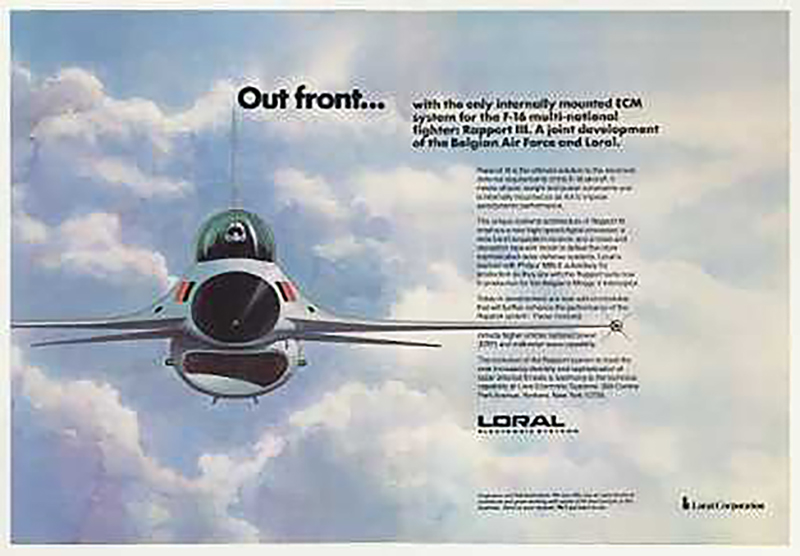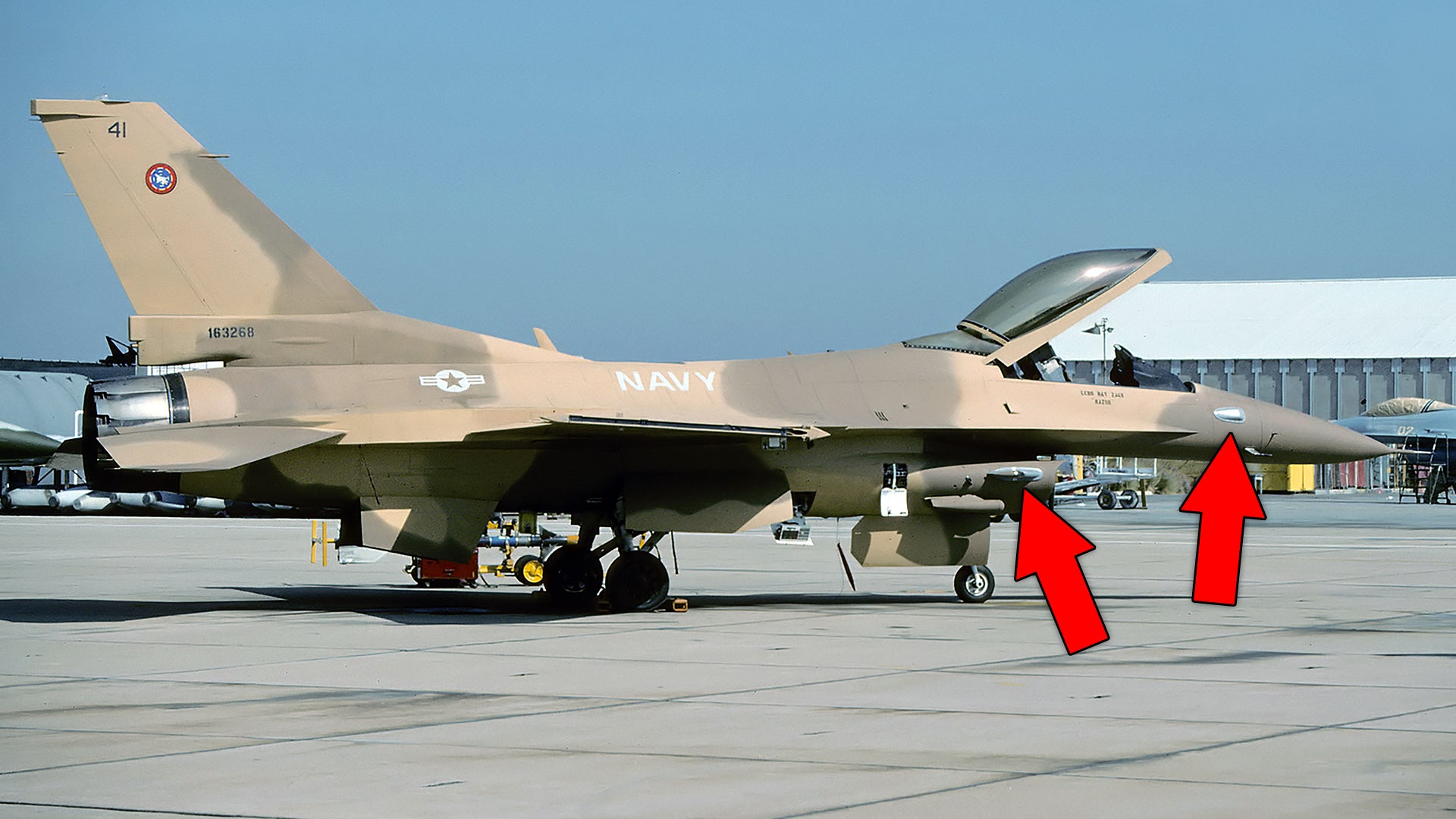The Navy’s purpose-built F-16N aggressors remain arguably the most fascinating variant of the highly diverse F-16 Viper family. The type’s remarkably short, but hard flown career, lasting just a decade, didn’t allow it to see much change in configuration. But at least one F-16N, Bureau Number 163268, received a very curious and noticeable electronic warfare system upgrade around 1993. So, what was this mysterious system and how did it end up on a random Topgun F-16N? Here’s the story.
Make sure to read the definitive account on the Navy’s F-16N and what it was like to fly in this past War Zone special feature.
The unique electronic warfare system’s most prominent feature is a pair of blade-like antenna appendages on each side of the F-16N’s inlet structure. Because the aircraft’s running lights are also placed in that position, they are integrated into the edge of the streamlined antenna fairings. A pair of larger than normal antennas are also situated on both sides of the F-16s nose.

Beyond its visual appearance, the electronic warfare system on this lone F-16N—the only one we are certain received it—has a very colorful past. The system, which is known as the AN/ALQ-178 Rapid Alert Programmed Power management of Radar Targets III, or RAPPORT III, was originally developed by Loral, which eventually ended up in Lockheed hands. The all internally-mounted suite provided both passive radar warning receiver and active jamming functions into a single integrated system. It is capable of automatically detecting, classifying, locating, and countering hostile emitters.
RAPPORT III’s first customer was supposed to be the Belgium Air Force. That ended up not happening, but Israel embraced the at the time cutting-edge system and saw great success with it on their F-16Cs during operations over Lebanon. A version of it later went on to equip the Turkish Air Force and it was evaluated in the 1990s for use in a number of American fighters. The last U.S. version of the system was dubbed the AN/ALQ-202 and it could have equipped most tactical jets in the Pentagon’s stable at the time.

The best history we found on the system was from a Forecast International document on electronic warfare systems from the early 2000s. It gives a good overall synopsis of the system and its peculiar past:
The Rapid Alert Programmed Power management of Radar Targets (RAPPORT) electronic countermeasures system was the only internal integrated system of its type developed and produced by one manufacturer. Development began in the early 1970s for a competition sponsored by the Belgian AirForce. The installation targeted 85 Mirage 5BA and BR aircraft. In June 1975, (then) Loral was selected as the contractor and production began in 1978. In 1979, the Belgian Air Force tentatively decided to install a more advanced model, RAPPORT III, in all Belgian F-16s from the 53rd production aircraft, with the previous aircraft to be retrofitted. Because of budget problems, the program was postponed, and funding of RAPPORT III stopped by the Belgian Air Force.
ALQ-178(V) RAPPORT II production was completed in 1985 at 100 systems, with most installed on Belgian F-5BA/R aircraft. Experience with RAPPORT II was instrumental in deciding to adapt RAPPORT III in lieu of the standard US Air Force countermeasures suite for the Belgian F-16s, which would have used the ALR-69(V) and ALQ-119(V). The ALE-40(V) chaff/flare dispenser was retained.
The first production contract for RAPPORT III was awarded in December 1983. The $88 million contract was awarded by Israel. The Israeli Air Force installed the system in its F-16s and used it with remarkable success against the Syrian Air Force during the Lebanon campaign. Under a special agreement, the Belgian Air Force was kept informed of the RAPPORT III’s performance and subsequently decided to install the system on its own F-16s.

In mid-1985, the Belgian Air Force announced plans to restart the RAPPORT III program. The production plan granted the Teamco Co exclusive production rights, and the company set up manufacturing facilities in Belgium. From 1988 on, the Belgian Air Force provided the bulk of RAPPORT III funding. The total Belgian program for the RAPPORT III was valued at $180 million for 108 systems. In late 1988, after expending $33 million in development funds, Belgium dropped the RAPPORT III program because of escalating program costs, selecting Carapace, a combination RWR/jammer from France as a follow-on to RAPPORT II.
In 1989, Loral announced that the government of Turkey had placed a $325 million order for the self protection electronic countermeasures system for its new F-16s. The name RAPPORT III was replaced by the nomenclature ALQ-178(V). Turkey selected it to equip a major production run of F-16s. First deliveries were made in 1992.
Loral and Kavala (a Turkish holding company) formed a joint venture to produce ALQ-178(V) Self-ProtectionEW Suites (SPEWS) in Turkey. The joint venture was known as Mikrodalga Elektronik Sistemler (MiKES), and a production facility was operational by 1993. In 1998, MiKES announced that it would manufacture the ALQ-178(V)5 EW protection system for the Turkish Air Force’s Block 50 F-16s, rather than simply assemble the systems from components provided by Lockheed Martin (as it did with the ALQ-178(V)3).
In 1993, Loral offered a significantly enhanced ALQ-178(V) (the ALQ-202(V), Loral Autonomous Jammer – LAJ) as an alternative to the terminated ALQ-165(V) ASPJ [Airborne Self Protection Jammer]. The enhanced and repackaged system was offered to both the US Navy and international F-16 and F/A-18 customers. The company offered to pay the cost of a competitive fly-off between the LAJ and ASPJ. Test flights of the ALQ-178(V)3 began at Eglin AFB, Florida, in February 1993. The tests were completed in August. The ALQ-178/202(V) was offered to South Korea and Egypt for their F-16s, and to Finland and Switzerland for their F/A-18s. In 1994, Finland and Switzerland decided to procure the ALQ-165(V) ASPJ instead in a combined FMS/commercial program. South Korea followed suit in early 1997.
The US Navy awarded a contract for the Integrated Defensive ElectronicCountermeasure (IDECM) electronic warfare system for the F/A-18E/F in November 1995, eliminating any chance that the ALQ-202(V) would be procured for US F/A-18s.
Considering what we know about the system’s complicated history and the timing of the F-16N photograph, shot in October of 1993 on Topgun’s ramp at NAS Miramar, the jet is most likely equipped with a variant of the RAPPORT III that was tested just a couple of months prior. Using a Navy F-16 for some of the testing would have been very efficient as the system wouldn’t have to be integrated onto a new Navy platform, such as the Hornet or Tomcat. Still, it isn’t clear how long the Topgun Viper retained the system or what the conclusions its evaluators were. Considering the combat record of the system and its success with at least a handful of air arms, it likely gave Navy fleet fighters opposing it a run for their money.

There has been a decades-long debate over equipping fighters with internal electronic warfare suites or relying on podded systems. It can be far more expensive and harder to upgrade internal systems, but they can be tailored to the airframe and the aircraft’s mission more tightly and don’t cause the drag penalty that an external podded system does. In addition, they don’t occupy valuable stores hardpoints. On the other hand, internal systems, which take up space and add weight to the aircraft, are always installed, even when they are not needed.

Up until the last decade or so, podded systems were remarkably popular even for relatively modern 4th generation fighters. In fact, they were so effective that they could turn even older fighter jets into highly formidable foes when their use was combined with creative cooperative tactics. But the increasing importance of electronic warfare and the incredible situational awareness a fully integrated digital electronic warfare and surveillance suite provides has meant that internal systems are becoming very hot items. In fact, they have been a key component of keeping new and upgraded 4th generation fighter designs relevant, with aircraft like the F-15, F-16, Super Hornet, and foreign offerings featuring various forms of these systems. They also often feature advanced towed decoys and other emerging expendable countermeasures capabilities. Taken as a whole, they are known to be absolute game-changers in terms of survivability. 5th generation fighters, with their high degree of sensor fusion, have these systems as a necessity.
So, in some ways, RAPPORT III was ahead of its time and helped blaze a trail for the advanced internal electronic warfare suites that are so prevalent in today’s fighter market.
That being said, at least one F-16N, even if for just a period of time in the early to mid-1990s, was the most formidable aggressor Viper on the block. And considering the stripped-down hotrod-like F-16N’s already notorious reputation, that’s really saying something.

A huge thanks to aviation journalist and photographer Peter Boschert for sharing his rare F-16N shot with us. Make sure to check out more of his awesome work here.
Contact the author: Tyler@thedrive.com
